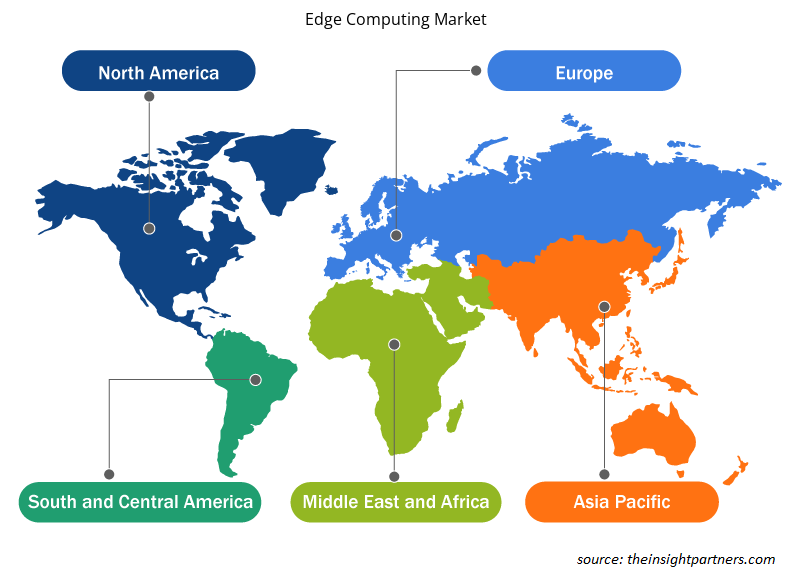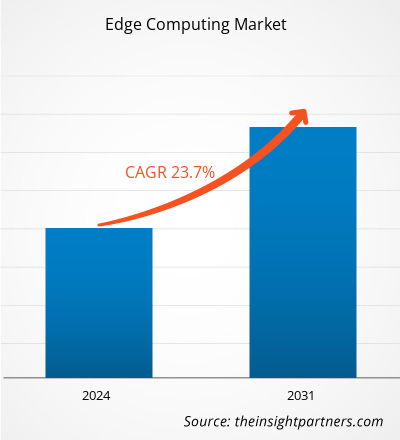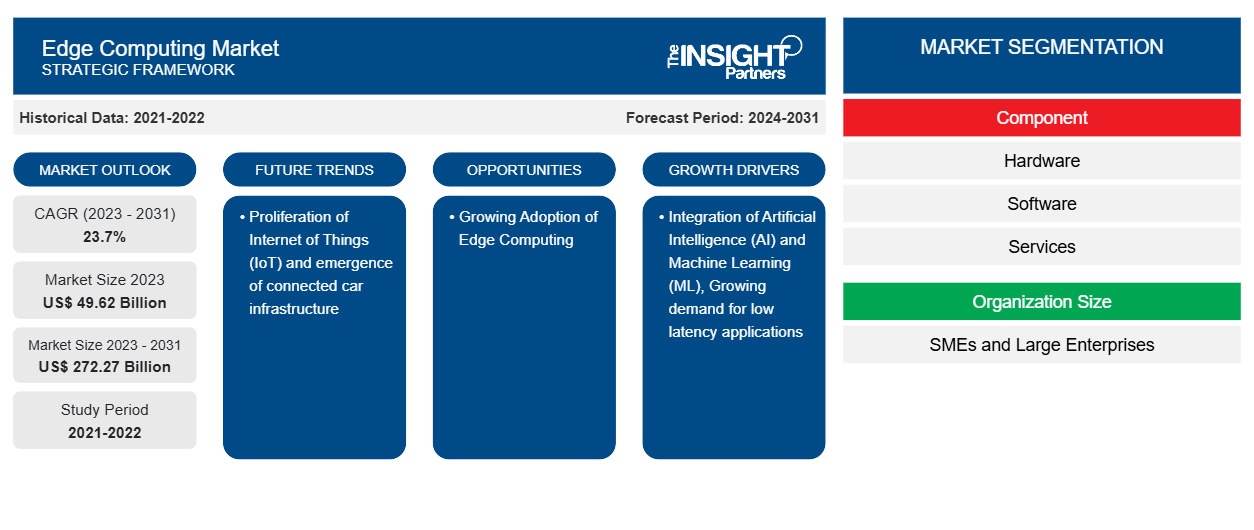Der Edge-Computing-Markt soll von 49,62 Milliarden US-Dollar im Jahr 2023 auf 272,27 Milliarden US-Dollar im Jahr 2031 wachsen; von 2023 bis 2031 wird eine durchschnittliche jährliche Wachstumsrate von 23,7 % erwartet. Die Verbreitung des Internets der Dinge (IoT) und die Entstehung einer Infrastruktur für vernetzte Fahrzeuge werden voraussichtlich ein wichtiger Trend auf dem Markt sein.
Edge Computing Marktanalyse
Der Aufstieg des Edge Computing bedeutet einen erheblichen Wandel in der Art und Weise, wie wir Daten verarbeiten und verwalten. Sein Potenzial, Echtzeit-Computing, erhöhte Bandbreiteneffizienz und verbesserte Sicherheit bereitzustellen, hat weitreichende Konsequenzen für viele Branchen. Die disruptiven Auswirkungen des Edge Computing sind in Bereichen von der Gesundheitsversorgung bis hin zu Smart Cities und Industrie offensichtlich. Edge Computing hat sich zu einer Schlüsselarchitektur entwickelt, die verteiltes Computing und Edge AI unterstützt. Mit anderen Worten: Edge Computing hält Rechendaten und Speicher in der Nähe des Benutzers, sei es durch Netzwerk oder geografische Distanz. Die Datenverarbeitung kann oft auf dem Gerät selbst erfolgen. Daher wird erwartet, dass die Nachfrage nach Edge Computing im Prognosezeitraum steigen wird.
Edge Computing Markt Branchenübersicht
Edge Computing ist ein neues Computerparadigma, das sich auf eine Reihe von Netzwerken und Geräten bezieht, die sich beim Benutzer oder in dessen Nähe befinden. Edge-Verarbeitung bringt Daten näher an den Ort, an dem sie generiert werden, und ermöglicht so schnellere und größere Verarbeitungsraten und -volumina, was zu umsetzbareren Antworten in Echtzeit führt. Edge Computing hat bestimmte deutliche Vorteile gegenüber herkömmlichen Modellen, bei denen die Computerkapazität in einem Rechenzentrum vor Ort konzentriert ist. Durch die Verlagerung der Datenverarbeitung an den Rand können Unternehmen physische Vermögenswerte besser verwalten und nutzen und gleichzeitig neue interaktive, menschliche Erfahrungen schaffen. Zu den Anwendungsszenarien von Edge Computing gehören unter anderem selbstfahrende Autos, autonome Roboter und Daten intelligenter Geräte.
Passen Sie diesen Bericht Ihren Anforderungen an
Sie erhalten kostenlos individuelle Anpassungen an jedem Bericht, einschließlich Teilen dieses Berichts oder einer Analyse auf Länderebene, eines Excel-Datenpakets sowie tolle Angebote und Rabatte für Start-ups und Universitäten.
-
Holen Sie sich die wichtigsten Markttrends aus diesem Bericht.Dieses KOSTENLOSE Beispiel umfasst eine Datenanalyse von Markttrends bis hin zu Schätzungen und Prognosen.
Treiber und Chancen des Edge Computing-Marktes
Integration von künstlicher Intelligenz (KI) und maschinellem Lernen (ML) zur Förderung des Marktwachstums
In den letzten Jahren hat das Internet der Dinge (IoT) erheblich an Akzeptanz gewonnen. IoT hat die Entwicklung künstlicher Intelligenz (KI) erheblich beschleunigt, indem es ausreichend Daten für Modelltraining und Inferenz liefert. Mit der fortschreitenden Entwicklung und weit verbreiteten Einführung von IoT hat das Cloud Computing begonnen, eine zunehmende Anzahl von Problemen aufzudecken. Wenn beispielsweise von globalen Endgeräten erstellte Daten in einer zentralisierten Cloud berechnet und gespeichert werden, würde dies eine Reihe von Problemen verursachen, wie z. B. geringen Durchsatz, hohe Latenz, Bandbreitenengpässe, Datenschutz, zentralisierte Schwachstellen und zusätzliche Kosten. Um die oben beschriebenen Schwierigkeiten des Cloud Computing zu lösen, hat ein neues Computing-Paradigma namens Edge Computing (EC) großes Interesse geweckt. Ausgedrückt besteht die zentrale Idee des EC-Modells darin, Datenverarbeitungs-, Speicher- und Rechenprozesse, die zuvor von der Cloud benötigt wurden, an den Rand des Netzwerks in der Nähe der Endgeräte zu verlagern. Dies reduziert die Datenübertragungszeit und die Reaktionszeiten der Geräte, entlastet den Netzwerkbandbreitendruck, senkt die Datenübertragungskosten und erreicht eine Dezentralisierung. Daher wird erwartet, dass die Integration von KI und ML das Wachstum des Edge Computing-Marktes im Prognosezeitraum ankurbeln wird.IoT) has gained significant acceptance. IoT has significantly accelerated the development of artificial intelligence (AI) by supplying adequate data for model training and inference. With the continued development and widespread deployment of IoT, cloud computing has begun to disclose an increasing number of issues. For example, if data created by global terminal devices is computed and stored in a centralized cloud, it would cause a series of problems, such as low throughput, high latency, bandwidth bottlenecks, data privacy, centralized vulnerabilities, and additional costs. To solve the difficulties of cloud computing outlined above, a new computing paradigm known as edge computing (EC) has gained extensive interest. Expressed, the EC model's central notion is to move data processing, storage, and computing processes that were previously required by the cloud to the network's edge, near terminal devices. This reduces data transmission time and device response times, relieves network bandwidth pressure, lowers data transmission costs, and achieves decentralization. Thus, the integration of AI and ML is expected to boost the edge computing market growth during the forecast period.
Zunehmende Nutzung von Edge Computing
Es wird erwartet, dass Edge Computing branchenübergreifend große Auswirkungen haben wird. Während einige Branchen die Auswirkungen bereits zu spüren bekommen haben, sind andere eher Späteinsteiger. In den letzten Jahren haben sich Unternehmen aus verschiedenen Branchen dem Edge Computing zugewandt, um sowohl Teams für Betriebstechnologie (OT) als auch für Informationstechnologie (IT) zu stärken, unternehmenswichtige Anwendungen und Daten zu unterstützen und Kosten zu senken. Edge Computing hat in letzter Zeit aufgrund seiner Skalierbarkeit, seines leistungsstarken Analysemanagements und seiner Fähigkeit, Ausfallzeiten zu verhindern, an Attraktivität gewonnen. Edge OTs sind leistungsstarke Computergeräte, die die intelligente Fabrik antreiben, indem sie Maschinen und Geräte verwalten und sich auf erweiterte Analysen, Wartung und Augmented Reality konzentrieren. Auf der IT-Seite ist es unzureichend, sich bei der Verwaltung dieser Anwendungen nur auf OT-Teams zu verlassen, da diese immer ausgefeilter und wichtiger geworden sind. Da IT-Teams Spezialisten für Datenverwaltung, -management und -sicherheit sind, garantieren sie, dass all diese Variablen am Rand auftreten und dass skalierbare Technologien eingesetzt werden, um Geld zu sparen und Geschäftsrisiken zu reduzieren.OTs are powerful computing devices that will fuel the smart factory by managing machines and equipment, focusing on advanced analytics, maintenance, and augmented reality. On the IT side, as these applications have become more sophisticated and essential, relying just on OT teams to manage them is insufficient. Because IT teams are specialists in data governance, management, and security, they guarantee that all of these variables occur at the edge and that scalable technologies are deployed to save money and reduce business risk.
Segmentierungsanalyse des Edge-Computing-Marktberichts
Die wichtigsten Segmente, die zur Ableitung der Edge Computing-Marktanalyse beigetragen haben, sind Komponente, Anwendung, Unternehmensgröße und Branche.
- Basierend auf den Komponenten ist der Markt in Hardware, Software und Dienste segmentiert. Das Hardwaresegment hatte im Jahr 2023 den größten Anteil am Edge-Computing-Markt, was auf die zunehmende Verbreitung IoT-basierter Systeme aufgrund der steigenden Anzahl verbundener Geräte zurückzuführen ist.
- Der Edge-Computing-Markt ist nach Anwendung in Smart Cities, Industrial Internet of Things (IIoT), Content Delivery, Augmented Reality und Virtual Reality und andere unterteilt. Das Segment Smart Cities dürfte im Prognosezeitraum aufgrund zunehmender Initiativen zur Entwicklung intelligenter Infrastrukturen schneller wachsen.
- Der Markt ist nach Unternehmensgröße in kleine und mittlere Unternehmen sowie große Unternehmen segmentiert.
- Der Edge-Computing-Markt ist branchenbezogen in die Bereiche Fertigung, Energie und Versorgung, öffentliche Verwaltung, IT und Telekommunikation, Gesundheitswesen, Einzelhandel und Konsumgüter und Sonstige unterteilt.
Edge Computing Marktanteilsanalyse nach Geografie
Regional ist der Markt in Nordamerika, Europa, Asien-Pazifik, Naher Osten und Afrika sowie Süd- und Mittelamerika segmentiert.
Technologische Fortschritte wie das industrielle Internet der Dinge (IIoT), Industrie 4.0 und 5G-Netzwerkdienste sowie die Ausweitung des Ökosystems vernetzter Geräte haben zur Generierung riesiger Datenmengen geführt, die den Einsatz einer leistungsstarken Computerinfrastruktur erforderlich machen. Dies wiederum dürfte das Wachstum des Edge-Computing-Marktes im asiatisch-pazifischen Raum im Prognosezeitraum ankurbeln.
Regionale Einblicke in den Edge-Computing-Markt
Die regionalen Trends und Faktoren, die den Edge-Computing-Markt im Prognosezeitraum beeinflussen, wurden von den Analysten von Insight Partners ausführlich erläutert. In diesem Abschnitt werden auch die Marktsegmente und die Geografie des Edge-Computing-Marktes in Nordamerika, Europa, im asiatisch-pazifischen Raum, im Nahen Osten und Afrika sowie in Süd- und Mittelamerika erörtert.

- Holen Sie sich die regionsspezifischen Daten zum Edge-Computing-Markt
Umfang des Edge Computing-Marktberichts
| Berichtsattribut | Details |
|---|---|
| Marktgröße im Jahr 2023 | 49,62 Milliarden US-Dollar |
| Marktgröße bis 2031 | 272,27 Milliarden US-Dollar |
| Globale CAGR (2023 - 2031) | 23,7 % |
| Historische Daten | 2021-2022 |
| Prognosezeitraum | 2024–2031 |
| Abgedeckte Segmente |
Nach Komponente
|
| Abgedeckte Regionen und Länder |
Nordamerika
|
| Marktführer und wichtige Unternehmensprofile |
|
Marktteilnehmerdichte: Der Einfluss auf die Geschäftsdynamik
Der Edge-Computing-Markt wächst rasant, angetrieben durch die steigende Endnutzernachfrage aufgrund von Faktoren wie sich entwickelnden Verbraucherpräferenzen, technologischen Fortschritten und einem größeren Bewusstsein für die Vorteile des Produkts. Mit steigender Nachfrage erweitern Unternehmen ihr Angebot, entwickeln Innovationen, um die Bedürfnisse der Verbraucher zu erfüllen, und nutzen neue Trends, was das Marktwachstum weiter ankurbelt.
Die Marktteilnehmerdichte bezieht sich auf die Verteilung der Firmen oder Unternehmen, die in einem bestimmten Markt oder einer bestimmten Branche tätig sind. Sie gibt an, wie viele Wettbewerber (Marktteilnehmer) in einem bestimmten Marktraum im Verhältnis zu seiner Größe oder seinem gesamten Marktwert präsent sind.
Die wichtigsten auf dem Edge-Computing-Markt tätigen Unternehmen sind:
- ADLINK-Technologie
- Amazon Web Services, Inc.
- Dell-Technologien
- EdgeConnex Inc.
- Nebelhorn-Systeme
Haftungsausschluss : Die oben aufgeführten Unternehmen sind nicht in einer bestimmten Reihenfolge aufgeführt.

- Überblick über die wichtigsten Akteure auf dem Edge-Computing-Markt
Neuigkeiten und aktuelle Entwicklungen zum Edge Computing-Markt
Der Edge-Computing-Markt wird durch die Erfassung qualitativer und quantitativer Daten nach Primär- und Sekundärforschung bewertet, die wichtige Unternehmenspublikationen, Verbandsdaten und Datenbanken umfasst. Einige der Entwicklungen auf dem Edge-Computing-Markt sind unten aufgeführt:
- Dell Technologies hat Dell NativeEdge vorgestellt, eine Edge-Operations-Softwareplattform, die Unternehmen dabei helfen soll, sichere Edge-Bereitstellungen zu vereinfachen und zu optimieren. Damit können Kunden Edge-Operationen über Tausende von Geräten und Standorten hinweg optimieren, vom Edge bis hin zu zentralen Rechenzentren und mehreren Clouds. (Quelle: Dell Technologies, Pressemitteilung, Mai 2023)
Abdeckung und Ergebnisse des Edge Computing-Marktberichts
Die Marktprognose für Edge Computing wird auf der Grundlage verschiedener sekundärer und primärer Forschungsergebnisse geschätzt, wie z. B. wichtiger Unternehmenspublikationen, Verbandsdaten und Datenbanken. Der Marktbericht „Edge Computing Market Size and Forecast (2021–2031)“ bietet eine detaillierte Analyse des Marktes, die die folgenden Bereiche abdeckt:
- Edge Computing Marktgröße und Prognose auf globaler, regionaler und Länderebene für alle wichtigen Marktsegmente, die im Rahmen des Berichts abgedeckt sind
- Edge Computing Markttrends sowie Marktdynamik wie Treiber, Einschränkungen und wichtige Chancen
- Detaillierte PEST/Porters Five Forces- und SWOT-Analyse
- Edge-Computing-Marktanalyse mit wichtigen Markttrends, globalen und regionalen Rahmenbedingungen, wichtigen Akteuren, Vorschriften und aktuellen Marktentwicklungen
- Branchenlandschaft und Wettbewerbsanalyse, die die Marktkonzentration, Heatmap-Analyse, prominente Akteure und aktuelle Entwicklungen auf dem Edge-Computing-Markt umfasst
- Detaillierte Firmenprofile.
- Historische Analyse (2 Jahre), Basisjahr, Prognose (7 Jahre) mit CAGR
- PEST- und SWOT-Analyse
- Marktgröße Wert/Volumen – Global, Regional, Land
- Branchen- und Wettbewerbslandschaft
- Excel-Datensatz
Aktuelle Berichte
Verwandte Berichte
Erfahrungsberichte
Grund zum Kauf
- Fundierte Entscheidungsfindung
- Marktdynamik verstehen
- Wettbewerbsanalyse
- Kundeneinblicke
- Marktprognosen
- Risikominimierung
- Strategische Planung
- Investitionsbegründung
- Identifizierung neuer Märkte
- Verbesserung von Marketingstrategien
- Steigerung der Betriebseffizienz
- Anpassung an regulatorische Trends























 Kostenlose Probe anfordern für - Edge-Computing-Markt
Kostenlose Probe anfordern für - Edge-Computing-Markt